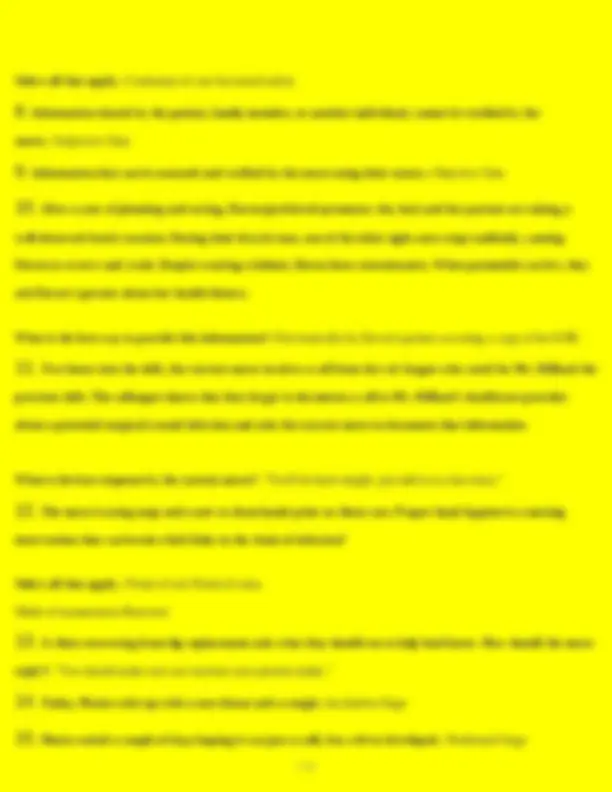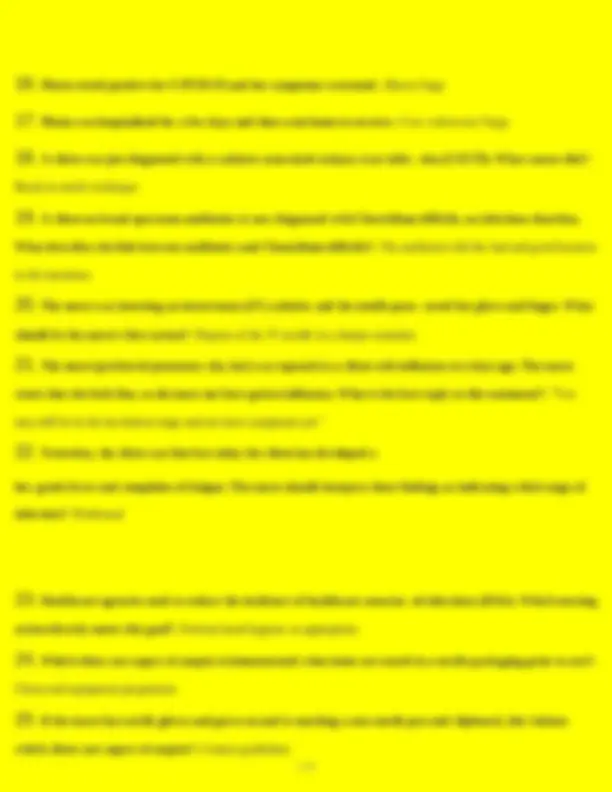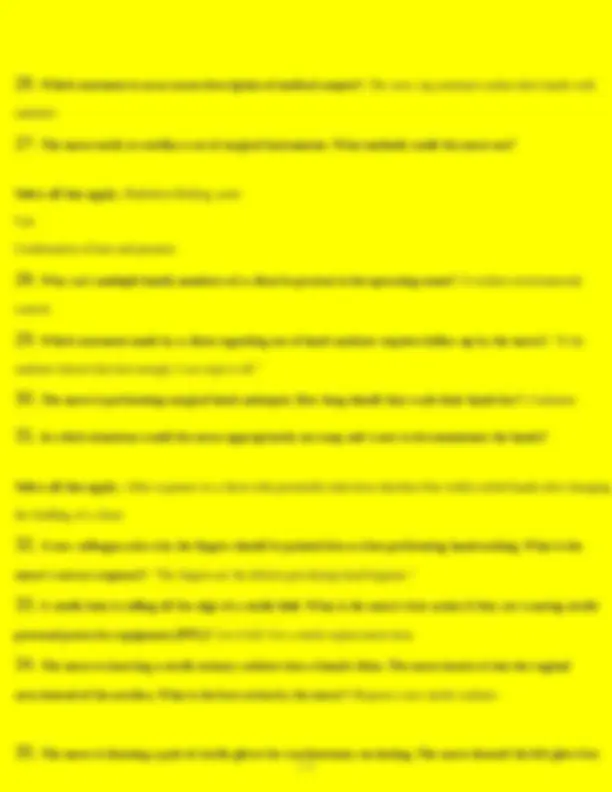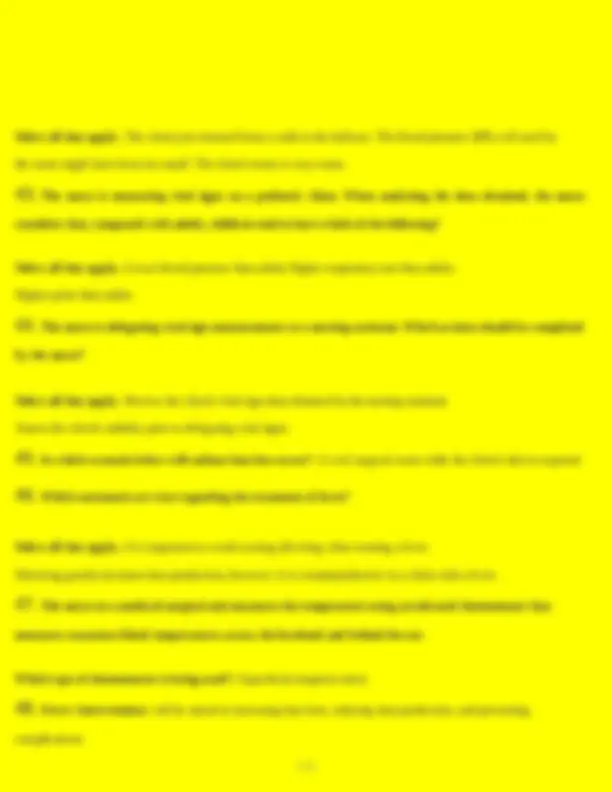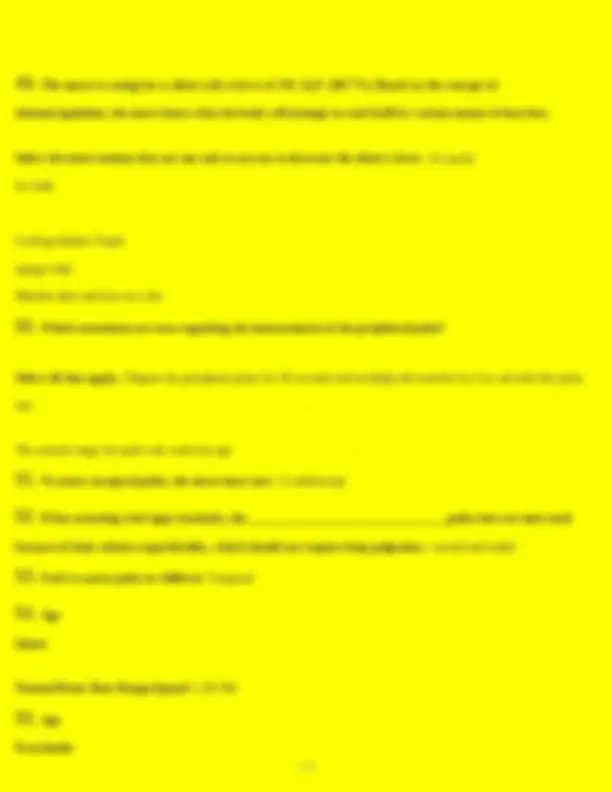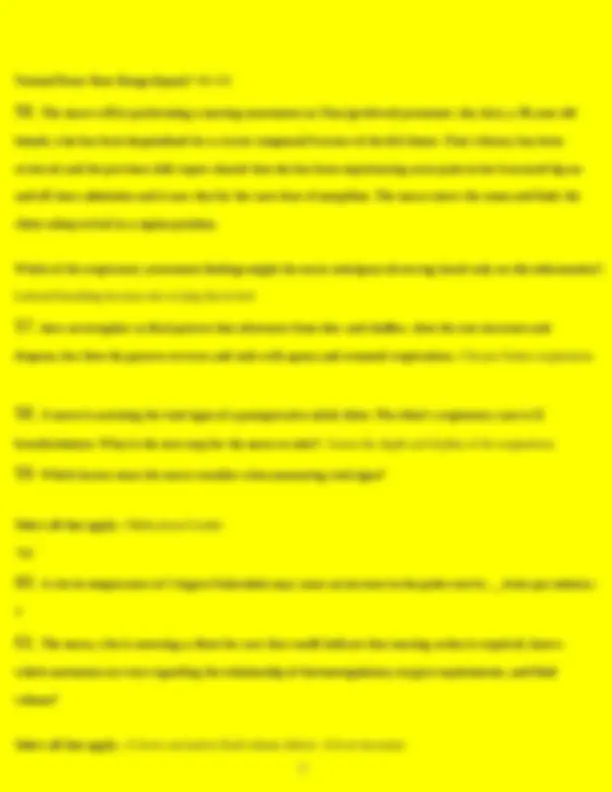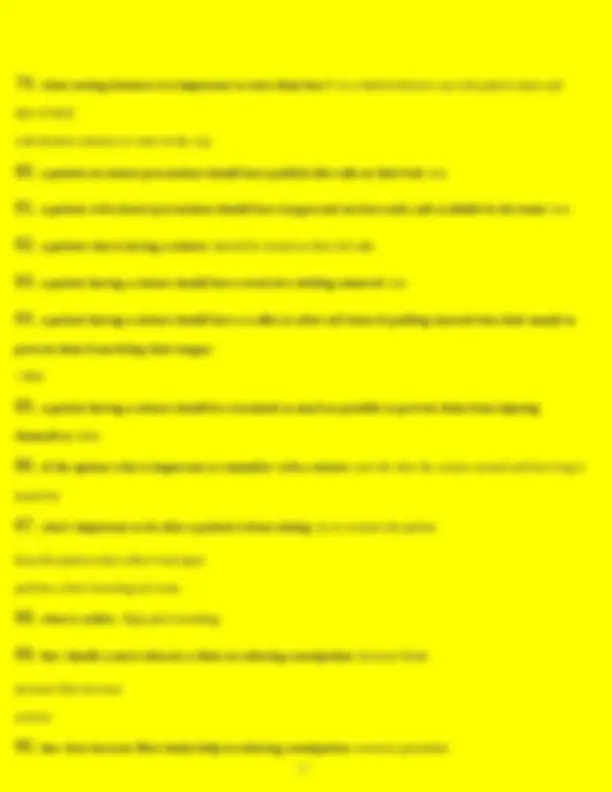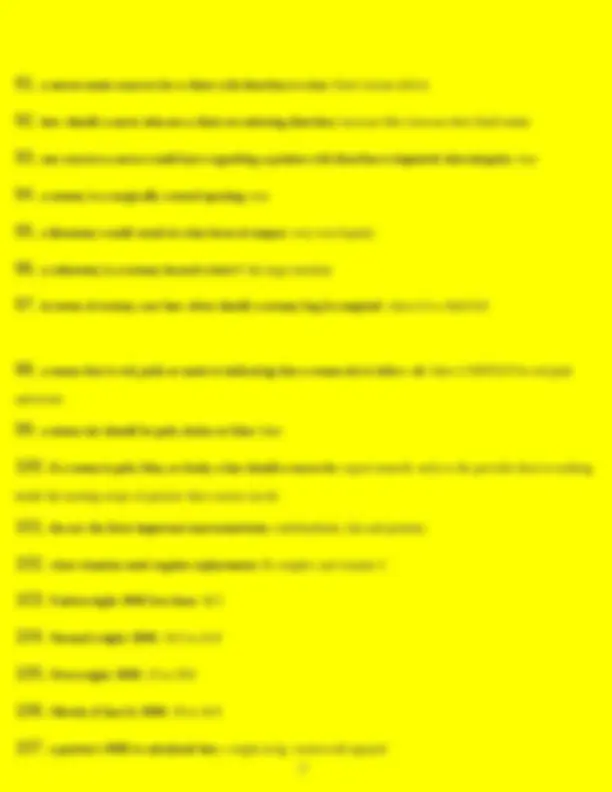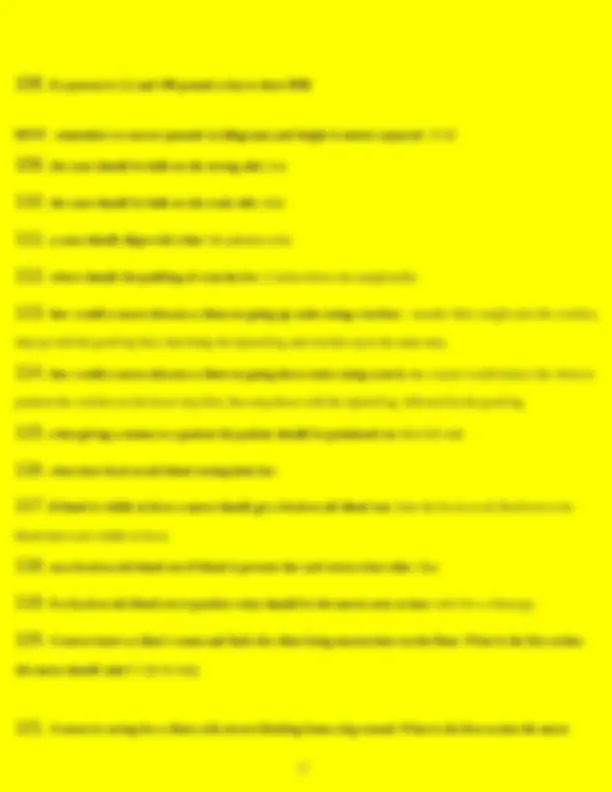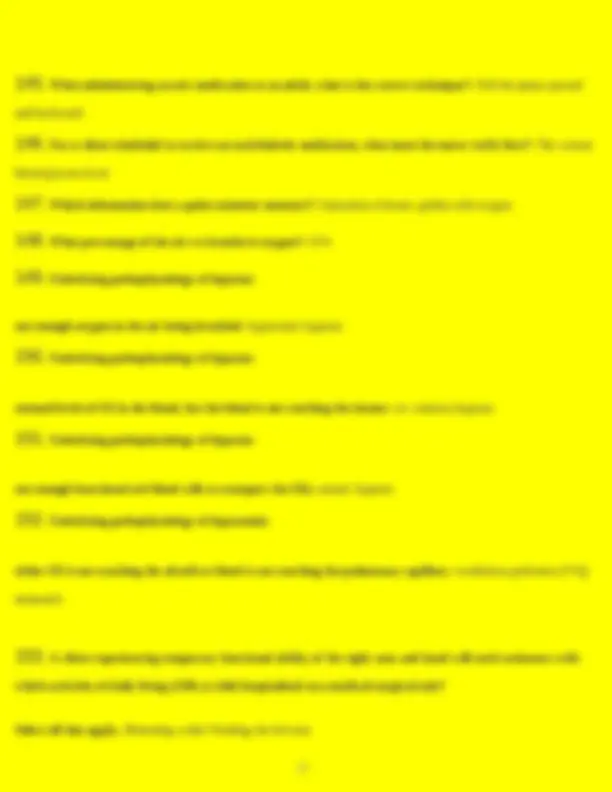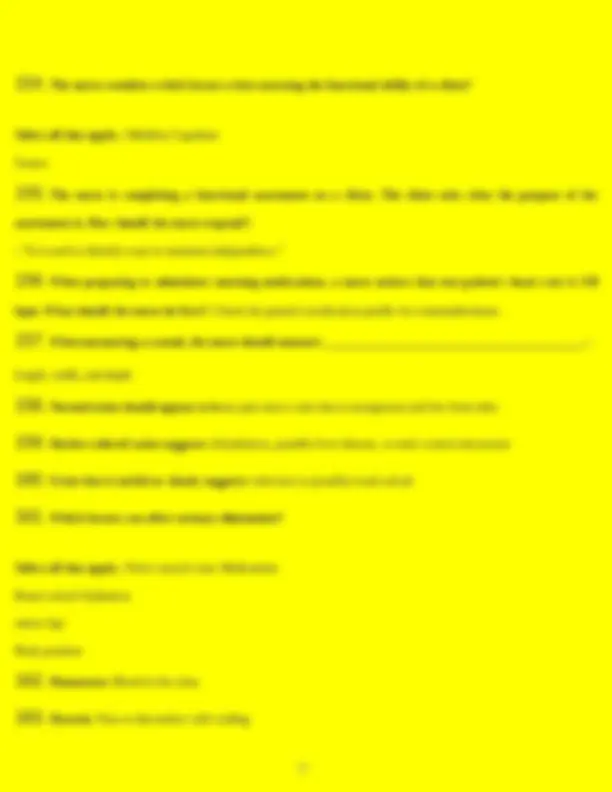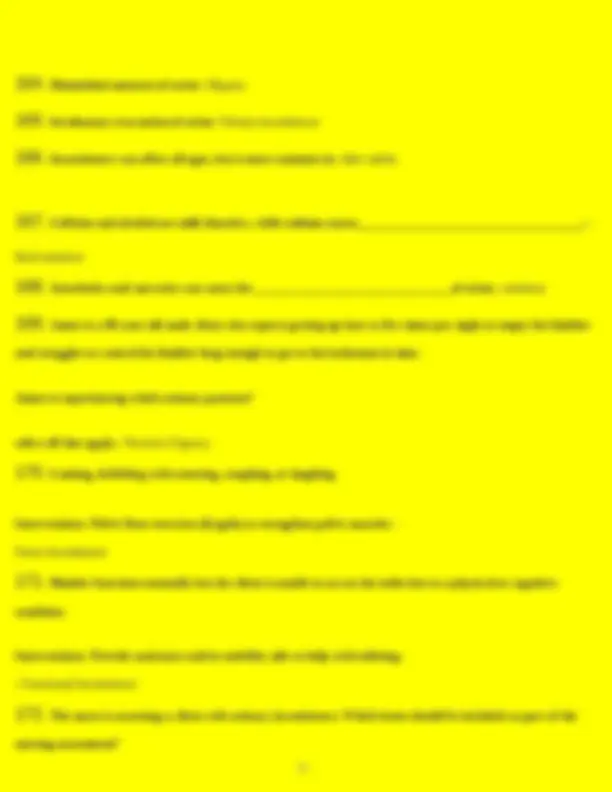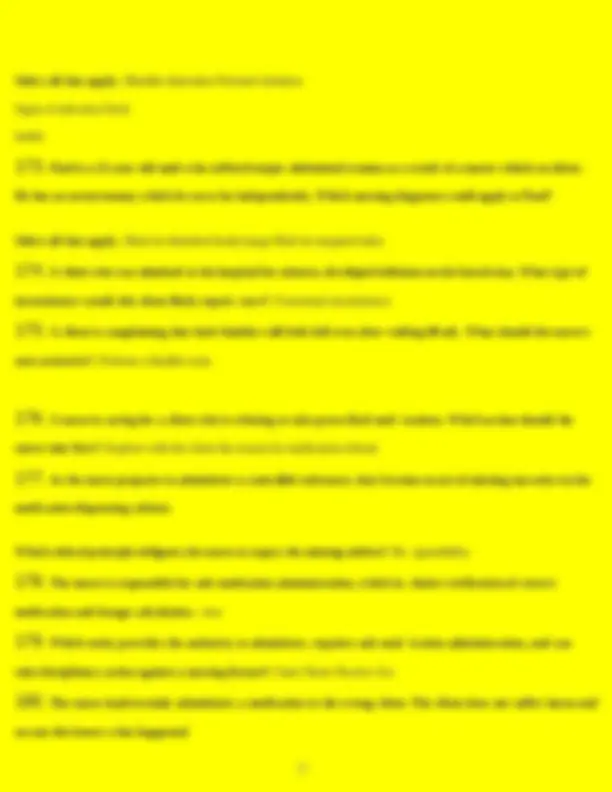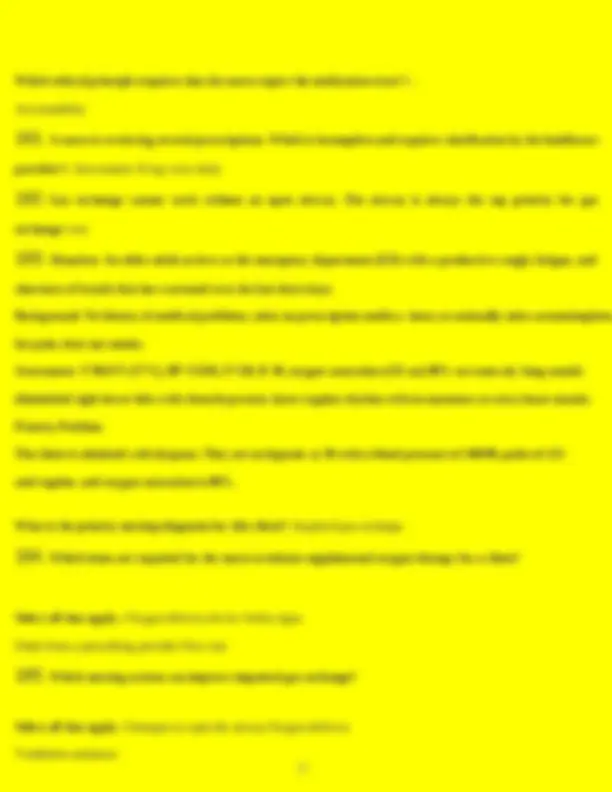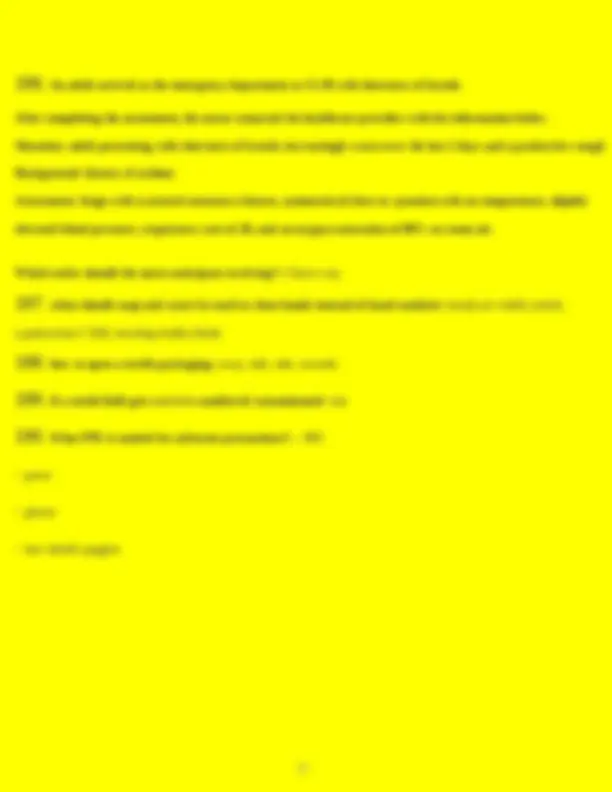Download Chamberlain University NR 224 fundamentals skills Final comprehensive exam review 2025 and more Exams Nursing in PDF only on Docsity!
1 / 23
Chamberlain University NR 224 fundamentals
skills Final comprehensive exam review
1. What factors impact the nurse's ability to recognize and cluster clinical cues?: Understanding of
pathological changes within the body Knowledge of normal human anatomy Experience in the clinical setting Ability to identify a single, significant cue and follow up
2. Complete the nursing diagnosis statements below by dragging the diagno- sis words/phrases to the
corresponding etiology.: Anxiety - Related to Hospital- ization Ineffective airway clearance - Related to Bronchitis Risk for imbalanced body temperature - Related to Hypothalamic dysfunction Decreased cardiac output - Related to Hypovolemia Constipation - Related to Low-fiber diet
3. Patient Name: Gladys Smith Age: 58 Gender: Female
Ms. Smith lives alone. Up until four weeks ago, she was healthy and not taking any medication. Although Mrs. Smith has been tiring easily, she attributes that to a project at work that is behind schedule. no known allergies recent medical history: cerebral vascular accident (CVA, stroke) 4 weeks prior to admission non-ambulatory being admitted to a rehabilitation facility from the hospital
2 / 23 "I am so weak I cannot feed myself or brush my teeth." "All I want to do is sleep." "The doctor says I may never live by myself again." "My clothes are too big since I've lost so much weight." weight 100 lb (down from 115 lb when admitted to hospital) limited range of motion bilateral shoulders non-ambulatory, can transfer from chair to bed using a walker thick, oral secretions sores in mouth halitosis speaks slowly and quietly: Nutritional status
4. After treatment with intravenous fluids and medication to lessen the cramps, Jim is discharged from urgent
care and told to follow up with his primary care provider within two days. A nurse from the urgent care center called Jim the next day to check on his recovery. What cues will the nurse ask about to determine if Jim's status is improving? Select all that apply.: Whether the fever is gone Number of bowel movements Presence of abdominal pain
5. A longitudinal record of an individual's interactions with the healthcare system.: Electronic Health Record
(EHR)
6. The legal record documenting a single encounter between an individual and a healthcare professional.:
Electronic Medical Record (EMR)
7. What are the advantages to clients that are realized by using an electronic health record (EHR)?
4 / 23
16. Maria tested positive for COVID-19 and her symptoms worsened.: Illness Stage
17. Maria was hospitalized for a few days and then went home to recover.: Con- valescence Stage
18. A client was just diagnosed with a catheter-associated urinary tract infec- tion (CAUTI). What causes this?:
Break in sterile technique
19. A client on broad spectrum antibiotics is now diagnosed with Clostridium difficile, an infectious diarrhea.
What describes the link between antibiotics and Clostridium difficile?: The antibiotics kill the bad and good bacteria in the intestines.
20. The nurse was inserting an intravenous (IV) catheter and the needle punc- tured her glove and finger. What
should be the nurse's first action?: Dispose of the IV needle in a sharps container.
21. The nurse (preferred pronouns: she, her) was exposed to a client with influenza two days ago. The nurse
states that she feels fine, so she must not have gotten influenza. What is the best reply to this statement?: "You may still be in the incubation stage and not have symptoms yet."
22. Yesterday, the client was fine but today the client has developed a
low-grade fever and complains of fatigue. The nurse should interpret these findings as indicating which stage of infection?: Prodromal
23. Healthcare agencies need to reduce the incidence of healthcare-associat- ed infections (HAIs). Which nursing
action directly meets this goal?: Perform hand hygiene as appropriate.
24. Which client care aspect of asepsis is demonstrated when items are stored in a sterile packaging prior to use?:
Client and equipment preparation
25. If the nurse has sterile gloves and gown on and is touching a non-sterile pen and clipboard, this violates
which client care aspect of asepsis?: Contact guidelines
5 / 23
26. Which statement is an accurate description of medical asepsis?: The nurs- ing assistant washes their hands with
sanitizer.
27. The nurse needs to sterilize a set of surgical instruments. What methods could the nurse use?
Select all that apply.: Radiation Boiling water Gas Combination of heat and pressure
28. Why can't multiple family members of a client be present in the operating room?: It violates environmental
control.
29. Which statement made by a client regarding use of hand sanitizer requires follow-up by the nurse?: "If the
sanitizer doesn't dry fast enough, I can wipe it off."
30. The nurse is performing surgical hand antisepsis. How long should they wash their hands for?: 4 minutes
31. In which situations would the nurse appropriately use soap and water to decontaminate the hands?
Select all that apply.: After exposure to a client with potentially infectious diarrhea Has visibly soiled hands after changing the bedding of a client
32. A new colleague asks why the fingers should be pointed down when performing handwashing. What is the
nurse's correct response?: "The fingers are the dirtiest part during hand hygiene."
33. A sterile item is rolling off the edge of a sterile field. What is the nurse's best action if they are wearing sterile
personal protective equipment (PPE)?: Let it fall. Get a sterile replacement item.
34. The nurse is inserting a sterile urinary catheter into a female client. The nurse inserts it into the vaginal
area instead of the urethra. What is the best action by the nurse?: Request a new sterile catheter.
35. The nurse is donning a pair of sterile gloves for tracheostomy suctioning. The nurse donned the left glove but
7 / 23 Upon review of the client's chart, which site/method of temperature measure- ment would you avoid for this client?: Rectal
42. After obtaining a set of vital signs on a client, the nurse determines that the results are abnormal for this
client. Which factors may have impacted the client's vital signs?
8 / 23 Select all that apply.: The client just returned from a walk in the hallway. The blood pressure (BP) cuff used by the nurse might have been too small. The client's room is very warm.
43. The nurse is measuring vital signs on a pediatric client. When analyzing the data obtained, the nurse
considers that, compared with adults, children tend to have which of the following? Select all that apply.: Lower blood pressure than adults Higher respiratory rate than adults Higher pulse than adults
44. The nurse is delegating vital sign measurements to a nursing assistant. Which actions should be completed
by the nurse? Select all that apply.: Review the client's vital sign data obtained by the nursing assistant. Assess the client's stability prior to delegating vital signs.
45. In which scenario below will radiant heat loss occur?: A cool surgical room while the client's skin is exposed
46. Which statements are true regarding the treatment of fever?
Select all that apply.: It is important to avoid causing shivering when treating a fever. Shivering greatly increases heat production; however, it is counterproductive in a client with a fever.
47. The nurse on a medical-surgical unit measures the temperature using an infrared thermometer that
measures cutaneous blood temperatures across the forehead and behind the ear. Which type of thermometer is being used?: Superficial temporal artery
48. Fever: Interventions: will be aimed at increasing heat loss, reducing heat production, and preventing
complications
10 / 23 Normal Heart Rate Range (bpm)?: 80- 110
56. The nurse will be performing a nursing assessment on Tina (preferred pronouns: she, her), a 38-year-old
female, who has been hospitalized for a recent compound fracture of the left femur. Tina's history has been reviewed and the previous shift report shared that she has been experiencing acute pain in her fractured leg on and off since admission and is now due for her next dose of morphine. The nurse enters the room and finds the client asleep in bed in a supine position. Which of the respiratory assessment findings might the nurse anticipate observing based only on this information?: Labored breathing because she is lying flat in bed
57. have an irregular cyclical pattern that alternates from slow and shallow, then the rate increases and
deepens, but then the pattern reverses and ends with apnea and resumed respirations.: Cheyne-Stokes respirations
58. A nurse is assessing the vital signs of a postoperative adult client. The client's respiratory rate is 22
breaths/minute. What is the next step for the nurse to take?: Assess the depth and rhythm of the respirations.
59. Which factors must the nurse consider when measuring vital signs?
Select all that apply.: Medications Gender Age
60. A rise in temperature of 1 degree Fahrenheit may cause an increase in the pulse rate by beats per minute.:
61. The nurse, who is assessing a client for cues that would indicate that nursing action is required, knows
which statements are true regarding the relationship of thermoregulation, oxygen requirements, and fluid volume? Select all that apply.: A fever can lead to fluid volume deficit. A fever increases
11 / 23 metabolism.
62. Adam, a 54-year-old client on bed rest, has a Stage 1 pressure injury on the coccyx. Which interventions
should the nurse implement? Select all that apply.: Provide proper skin care. Reposition the client every 1 to 2 hours. Get the client a specialty air or foam mattress.
63. A 77-year-old is recovering from spinal surgery and using a walker as an assistive device. The client states, "I
don't want any visitors or to go anywhere. No one should see me using a walker. I want to be left alone." What is the most appropriate nursing diagnosis? Social isolation
64. An 80-year-old fell at home and was not found for three days. The client was admitted to the hospital with a
fractured hip. Which complications can occur due to immobility? Select all that apply.: Urinary retention Embolus Muscle atrophy
65. The nurse is assessing a client who recently had surgery. Lung sounds on the right base are diminished and
there are no breath sounds in the left base. What complication does the nurse suspect?: Atelectasis
66. A client has been on prolonged bed rest but now is able to get up. What should the nurse assess for?
Select all that apply.: Activity tolerance Range of motion (ROM) Gait Strength
67. Mary Brenner is a 60-year-old client who is less than 24 hours post-op- erative from abdominal surgery.
To prevent immobility complications, what priority nursing intervention should be implemented?: Ambulate
13 / 23
79. when storing dentures it is important to store them how?: in a labeled denture cup with patient name and
date of birth with denture solution or water in the cup
80. a patient on seizure precautions should have padded side rails on their bed: true
81. a patient with seizure precautions should have oxygen and suction ready and available in the room: true
82. a patient who is having a seizure: should be turned on their left side
83. a patient having a seizure should have restrictive clothing removed: true
84. a patient having a seizure should have a wallet or other soft form of padding inserted into their mouth to
prevent them from biting their tongue- : false
85. a patient having a seizure should be restrained as much as possible to prevent them from injuring
themselves: false
86. of the options what is important to remember with a seizure: note the time the seizure started and how long it
lasted for
87. what's important to do after a patient is done seizing: try to reorient the patient
keep the patient calm collect vital signs perform a brief neurological exam
88. what is strider: High pitch breathing
89. how should a nurse educate a client on reducing constipation: increase fluids
increase fiber increase activity
90. how does increase fiber intake help in reducing constipation: increases peristalsis
14 / 23
91. a nurses main concern for a client with diarrhea is what: fluid volume deficit
92. how should a nurse educate a client on reducing diarrhea: increase fiber increase their fluid intake
93. one concern a nurse would have regarding a patient with diarrhea is impaired skin integrity: true
94. a ostomy is a surgically created opening: true
95. a ileostomy would result in what form of output: very very liquidy
96. a colostomy is a ostomy located where?: the large intestine
97. in terms of ostomy care how often should a ostomy bag be emptied: when it is a third full
98. a stoma that is red, pink or moist is indicating that a stoma site is infect- ed: false it SHOULD be red pink
and moist
99. a stoma site should be pale, dusky or blue: false
100. if a stoma is pale, blue, or dusky what should a nurse do: report immedi- ately to the provider there is nothing
inside the nursing scope of practice that a nurse can do
101. the are the three important macronutrients: carbohydrates, fats and proteins
102. what vitamins need regular replacement: B complex and vitamin C
103. Underweight: BMI less than: 18.
104. Normal weight: BMI: 18.5 to 24.
105. Overweight: BMI: 25 to 29.
106. Obesity (Class I): BMI: 30 to 34.
107. a patient's BMI is calculated how: weight in kg / meters tall squared
16 / 23 should take?: Apply pressure to the wound.
122. A nurse assessing a client with chest pain should first:: Assess airway, breathing, and circulation.
123. A nurse finds a client who appears to be having a seizure. The first priority is to:: Protect the client from
injury.
124. If a client reports difficulty breathing, the nurse's first action should be to:: Elevate the head of the bed.
125. A nurse begins a shift and must prioritize tasks. The first client to see would be one who:: Has just
returned from surgery.
126. A client is visibly distressed and anxious about an upcoming surgery. The nurse's first priority should be
to:: Provide reassurance and emotional support.
127. In the event of discovering a medication error, the nurse's first action should be to:: Assess the client's
condition.
128. A client with a chest drain shows sudden onset of tachypnea and a drop in oxygen saturation to 85%. What
is the nurse's first priority?: Assess the chest drain system for disconnection or blockage.
129. A post-operative client reports severe pain at the surgical site, which appears red and swollen. What is
the nurse's first action?: Assess the wound for signs of infection.
130. During a blood transfusion, a client begins to exhibit signs of an allergic reaction. What is the first step the
nurse should take?: Stop the transfusion.
131. A client with a tracheostomy is experiencing difficulty breathing and the nurse observes increased
secretions. What is the first action?: Suction the tracheostomy.
132. A client with a history of renal stones is experiencing severe flank pain and nausea. What is the first
nursing action?: Give analgesics as prescribed.
133. A nurse is caring for a client with an indwelling urinary catheter who reports a sudden onset of lower
abdominal pain. What should the nurse assess first?: Catheter for patency and kinks.
17 / 23
134. Which intervention should a nurse prioritize for a client with stress uri- nary incontinence?: Pelvic floor
muscle exercises.
135. A client with urge incontinence would benefit most from which nursing intervention?: Bladder retraining.
136. When caring for a client with functional incontinence, what is the nurse's first action?: Assess the client's
mobility and access to the toilet.
137. A client with overflow incontinence is most likely to benefit from which nursing action?: Intermittent
catheterization.
138. A nurse is developing a care plan for a client experiencing nocturnal enuresis. What is the first step in
managing this condition: Set up a nighttime toileting schedule.
139. A client reports experiencing incontinence when coughing or sneezing. Which type of incontinence is most
likely?: Stress incontinence.
140. For a client with severe incontinence, what is an essential part of care to prioritize?: Application of skin
barrier creams.
141. When administering a new medication to a client, what is the first action a nurse should take?: Check the
client's medical history for allergies.
142. A nurse is preparing to administer an intravenous (IV) medication. What should the nurse prioritize to
ensure safety?: Confirm the client's identity.
143. A client has been prescribed a medication that the nurse suspects may interact with another ongoing
medication. What is the nurse's first action?: - Contact the prescribing physician to clarify.
144. What is the priority action before administering a medication with a known risk of causing
hypotension?: Monitor the client's blood pressure.
19 / 23
154. The nurse considers which factors when assessing the functional ability of a client?
Select all that apply.: Mobility Cognition Senses
155. The nurse is completing a functional assessment on a client. The client asks what the purpose of the
assessment is. How should the nurse respond?- : "It is used to identify ways to maintain independence."
156. When preparing to administer morning medications, a nurse notices that one patient's heart rate is 110
bpm. What should the nurse do first?: Check the patient's medication profile for contraindications.
157. When measuring a wound, the nurse should measure : -
length, width, and depth
158. Normal urine should appear to be a: pale straw color that is transparent and free from odor.
159. Darker-colored urine suggests: dehydration, possible liver disease, or med- ication interaction
160. Urine that is turbid or cloudy suggests: infection or possibly renal calculi.
161. Which factors can affect urinary elimination?
Select all that apply.: Pelvic muscle tone Medications Renal calculi Hydration status Age Body position
162. Hematuria: Blood in the urine
163. Dysuria: Pain or discomfort with voiding
20 / 23
164. Diminished amounts of urine: Oliguria
165. Involuntary evacuation of urine: Urinary incontinence
166. Incontinence can affect all ages, but is more common in: older adults.
167. Caffeine and alcohol are mild diuretics, while sodium causes : -
fluid retention
168. Anesthetics and narcotics can cause the of urine.: retention
169. James is a 90-year-old male client who reports getting up four to five times per night to empty his bladder
and struggles to control his bladder long enough to get to the bathroom in time. James is experiencing which urinary patterns? select all that apply.: Nocturia Urgency
170. Leaking, dribbling with sneezing, coughing, or laughing
Interventions: Pelvic floor exercises (Kegels) to strengthen pelvic muscles: - Stress Incontinence
171. Bladder functions normally but the client is unable to access the toilet due to a physical or cognitive
condition. Interventions: Provide assistance and/or mobility aids to help with toileting.- : Functional Incontinence
172. The nurse is assessing a client with urinary incontinence. Which items should be included as part of the
nursing assessment?

